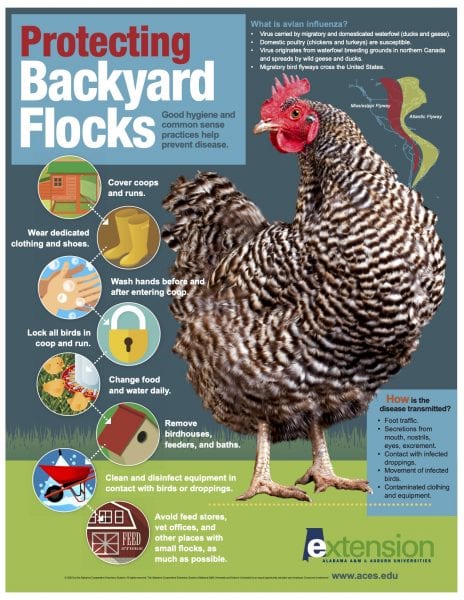Farming

AUBURN UNIVERSITY, Ala. – The Alabama Department of Agriculture and Industries (ADAI) confirmed a case of highly pathogenic avian influenza (HPAI) in a commercial pullet farm in Marshall County, Alabama.
ADAI released the following statement on Nov. 3: “It is critical for commercial and backyard poultry operations to remain alert and closely monitor the health of their poultry. The HPAI infected flock in Marshall County reinforces the need to continue following strict biosecurity measures, including keeping birds enclosed without access to wild birds or other domestic flocks.”
The poultry industry is a major economic component of Alabama’s economy. Most of the economic impact is generated from commercial poultry production, which occurs in large poultry houses. A smaller component of the poultry industry are the backyard flocks, which are raised mostly outdoors. The backyard, outdoor flock is most susceptible to avian influenza because of the greater chance of coming in contact with contaminated wild birds.
While the detection of HPAI in Alabama is not a welcome development, Alabama’s commercial poultry growers can take this opportunity to hone preexisting biosecurity measures on their operations.
Proper Biosecurity Key to Prevention
 Dianna Bourassa, a poultry specialist with the Alabama Cooperative Extension System, stresses that biosecurity measures are of critical importance for preventing and stopping the spread of HPAI to both backyard and commercial poultry flocks.
Dianna Bourassa, a poultry specialist with the Alabama Cooperative Extension System, stresses that biosecurity measures are of critical importance for preventing and stopping the spread of HPAI to both backyard and commercial poultry flocks.
“Good biosecurity is the best preventative measure we can use to avoid the spread of the disease into poultry flocks,” said Bourassa, who is also an associate professor of poultry science at Auburn University.
Commercial poultry producers in Alabama, and throughout the Southeast, have already increased their level of biosecurity. This increased security includes being extra cautious with visitors, wearing extra shoe covers and increasing sanitizing of shoes, just to name a few things.
Increased biosecurity measures will decrease the change of the disease spreading. This provides protection to not only the poultry producer, but also neighboring flocks.
The following is some basic advice to protect poultry flocks:
- Isolate birds from potential disease carriers by making the coop and its surrounding area unappealing to wild birds.
- Minimize visitor traffic near the chicken coop, as they may have stepped in something carrying the virus.
- Sanitize anything and everything entering the coop.
- Recognize when the birds are acting sick. In the case of avian influenza, the birds will be extremely sick.
Whether raising five, 50, 500 or 50,000+ chickens, preparing and following a good biosecurity program is important for maintaining the health and well-being of a poultry flock. If properly implemented, there is a good chance that a disease outbreak will not affect the flocks with a good biosecurity program in place.
Avian Influenza Transmission
This disease can transmit easily to backyard and commercial poultry flocks. Infected birds can shed the virus in secretions from the mouth, nostrils and eyes. They can also excrete the virus in their droppings. Contact with contaminated droppings is the most common means of bird-to-bird transmission. However, airborne secretions are another important means of transmission, especially within poultry houses.
It is not difficult to trace the spread of avian influenza between poultry facilities to the movement of infected birds or contaminated people and equipment, including clothing, boots and vehicles. If a grower suspects that their chickens are sick, they should contact their veterinarian, state diagnostic lab or a qualified expert, and get a diagnosis if possible.
While avian influenza is related to the flu that people might catch, there is little risk of human transmission from this particular subtype.
Is chicken safe to eat?
Yes, poultry is safe to eat. Infected flocks do not enter the human food chain. When a person identifies avian influenza in a flock, they euthanize the chickens and dispose of their remains, usually on the farm.
More Information
Alabama Extension offers more details about backyard poultry biosecurity in the following publications and resources:
- Avian Influenza FAQ
- Biosecurity for Backyard Poultry Flocks
- Protecting Backyard Flocks
- Submitting Samples to Alabama Diagnostic Laboratories
These resources can be found by searching avian influenza in the search bar of Alabama Extension’s website, www.aces.edu.

